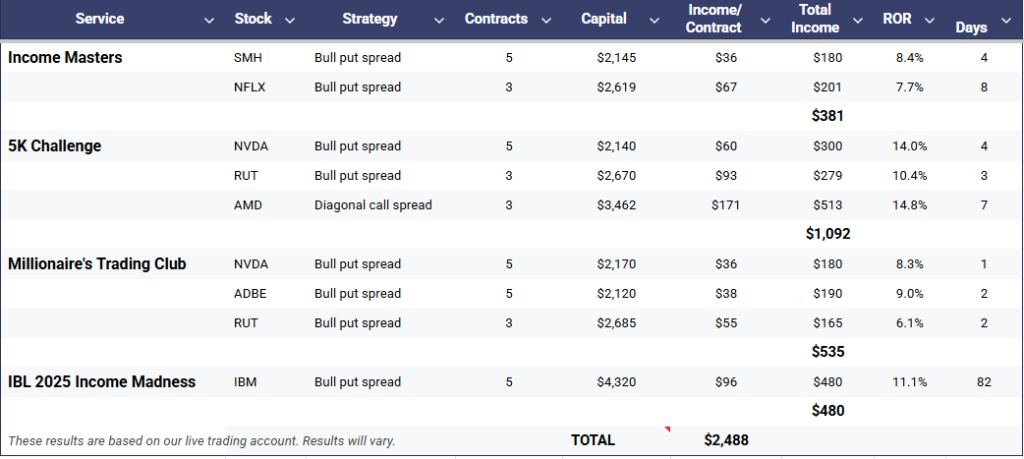We closed nine trades across our services last week, all of which were winners, racking up nearly $2,500 in cash in the live account.
Here are all the closed trades from the week of May 12-16:

As we’ve been discussing here, we held a Millionaire’s Trading Club virtual event. Over the course of three days of back-to-back trading, we put on 14 trades. We’ve already closed out three of those positions, booking $535 in cash in the live account. This puts us well on our way to hitting our $2,500 cash goal.
Looking at the table above, last week’s standout trade from a cash and rate-of-return perspective was the Advanced Micro Devices (AMD) diagonal call spread in the 5K Challenge program. This strategy has yielded some of our biggest winners year to date.
The rest of last week’s closeouts were bull put spreads, which is the most commonly used strategy across our services. And while the profit potential is generally smaller than with some other tactics like diagonal call spreads, this strategy is our most consistent income generator.
While both strategies express a neutral-to-bullish outlook, they employ distinct mechanics and cater to different market expectations and time horizons. Let’s take a closer look at the intricacies of each, including their construction, profit/loss characteristics and optimal usage scenarios.
The Foundational Belief: Mild Bullishness
Both strategies are predicated on the belief that the underlying asset price will either remain stable or experience a moderate increase. However, the way they capitalize on this belief, and the inherent risks and rewards involved, differ significantly.
Bull Put Spread: Short-Term Income and Defined Risk
The bull put spread is a credit spread, designed to generate income with defined and limited risk. It’s constructed by selling a higher-strike put option (closer to the current price), which generates premium, and buying a lower-strike put option (further out of the money) with the same expiration date that acts as a hedge, limiting the potential loss.
The Mechanics of Profit and Loss
The ideal scenario for a bull put spread is for the underlying price to remain at or above the higher short put strike at expiration. In this case, both puts expire worthless, and the trader retains the net credit received when establishing the spread (premium received from the short put minus the premium paid for the long put).
The maximum profit is capped at this net credit. The maximum loss, conversely, is also defined and occurs if the underlying price falls below the lower long put strike at expiration. This loss is calculated as the difference between the strike prices minus the net credit. The breakeven point is the higher short put strike minus the net credit.
Key Advantages:
- Defined and limited risk: The maximum loss is known upfront, which is a primary attraction of this strategy for risk-conscious traders.
- Income generation: The net credit provides immediate income, enhancing the probability of profit if the bullish thesis holds.
- Positive theta: Time decay works in favor of the bull put spread. As expiration approaches, the value of both puts erodes, benefiting the short put more significantly (as it’s closer to the money).
- Lower capital requirements: The purchased put significantly reduces margin requirements versus a standalone cash-secured put.
Bull Put Spread: Optimal Usage
Bull put spreads are best employed when:
- You have a short-term neutral to moderately bullish outlook.
- You believe the underlying price has a low probability of falling significantly below the lower strike by expiration.
- You want to generate income with a defined risk profile.
- Implied volatility is relatively high, allowing for a larger credit received.
Diagonal Call Spread: Longer-Term Bullishness and Time Arbitrage
The diagonal call spread is a debit spread. The trader first buys a longer-dated call option with a lower strike price. This is the “anchor” of the bullish position. They then sell a shorter-dated call option with a higher strike price. This generates income and partially offsets the cost of the long-dated call.
The Mechanics of Profit and Loss
The profit and loss profile of a diagonal call spread is more complex due to the differing expiration dates. A profit can be realized in several ways:
- The underlying price moves above the short call strike by the short-term expiration, allowing you to potentially buy back the short call for a profit or let it be assigned (if you want to sell the stock at that price).
- The value of the longer-dated call appreciates due to price movement or an increase in implied volatility.
- You strategically roll the short-term call (buy it back and sell another one with a later expiration and/or different strike) to manage the position over time.
The maximum potential profit is theoretically unlimited (on the long call), but realized profit in the short term is capped by the short call strike. The maximum loss is also defined but can be more intricate to calculate upfront, generally occurring if the price stays below the long call strike at the short-term expiration and the long-term call loses value.
Key Advantages:
- Lower initial cost: Selling the short-term call helps offset the cost of the longer-term call, making a longer-term bullish position more affordable.
- Potential for greater upside: Unlike the capped profit of a bull put spread, the longer-dated call offers the potential for significant gains if the underlying price moves substantially higher over time.
- Time arbitrage: You can potentially profit from the faster time decay of the shorter-term call compared to the longer-term call.
- Flexibility in management: The ability to roll the short-term call allows for active management and adaptation to changing market conditions.
Optimal Usage
Diagonal call spreads are best employed when:
- You have a moderately bullish outlook over a longer time frame.
- You expect some near-term price stability or gradual upward movement.
- You want to reduce the cost of a long call position.
- There is a favorable time value difference between the long and short calls (e.g., the shorter-term call has higher relative implied volatility).
Conclusion
While both the bull put spread and the diagonal call spread serve traders with a neutral-to-bullish bias, they are distinct tools with different applications. The bull put spread is a short-term income-generating strategy with defined risk and reward, ideal for capitalizing on price stability above a certain level. The diagonal call spread, on the other hand, is a longer-term play that reduces the cost of a bullish position and offers greater potential upside, albeit with more complex management and a different risk profile.
We’ll continue to utilize both strategies in our services. And we’ll keep you updated on our Millionaire’s Trading Club results as we continue to close out positions in the days and weeks ahead.


